

WE DO HOPE ALL THE READERS ARE ALLURED TO VISIT THE ISLAND IN ORDER TO LEARN AND EXPLORE MORE ITS UNIQUE PLACES OF INTEREST, VARIOUS TYPICAL LOCAL CULTURE, HOSPITALITY OF THE PEOPLE, ENVIRONMENTAL CONSERVATION AS WELL AS THE OTHER TOURIST ATTRACTIONS. BESIDES BALI ISLAND IS AND IDEAL PLACE FOR HAVING MICE AND HONEY MOON.


 Tirta is a Sanskrit word meaning water, holy water, river, or bathing place. It also means the holy place for pilgrimage as in the word tirtayatra. Tirtayatra has recently become popular amongst the Balinese. They do not only practice tirtayatra around Bali but also at temples in Java and some places in India. Several Balinese tour companies offer packaged tirtayatra tours to India, although they are not demanded as highly as the annual Muslim pilgrimage to Mekka, have been steadily on the increase. Bathing in the River Ganges is always included on India's tirtayatra itinerary. Tirtayatra to India is affordable only by the upper-middle and upper class Balinese Hindus. The lower-middle and lower class people do tirtayatra on auspicious days, such as at the full moon (purnama) to holy places in Bali and Java. The goal of tirtayatra is not only to pray and receive holy water but also to immerse participants in the holy atmosphere of the visited temples. Participants of tirtayatra often like to bring some holy water home and give them as gift to their family. Receiving holy water from India or other temples is always an invaluable gift for those who appreciate them. The origin of holy water reflects both spiritual and social hierarchy.
Tirta is a Sanskrit word meaning water, holy water, river, or bathing place. It also means the holy place for pilgrimage as in the word tirtayatra. Tirtayatra has recently become popular amongst the Balinese. They do not only practice tirtayatra around Bali but also at temples in Java and some places in India. Several Balinese tour companies offer packaged tirtayatra tours to India, although they are not demanded as highly as the annual Muslim pilgrimage to Mekka, have been steadily on the increase. Bathing in the River Ganges is always included on India's tirtayatra itinerary. Tirtayatra to India is affordable only by the upper-middle and upper class Balinese Hindus. The lower-middle and lower class people do tirtayatra on auspicious days, such as at the full moon (purnama) to holy places in Bali and Java. The goal of tirtayatra is not only to pray and receive holy water but also to immerse participants in the holy atmosphere of the visited temples. Participants of tirtayatra often like to bring some holy water home and give them as gift to their family. Receiving holy water from India or other temples is always an invaluable gift for those who appreciate them. The origin of holy water reflects both spiritual and social hierarchy. The bigger the ritual then the more different types of holy water are required from different temples. During the first Bali bombing cleansing ceremony, named 'Pamarisudha Karipubhaya', at ground zero in November 2002, holy water was taken from as far away from the temple of Mount Semeru in East Java as well as Mount Rinjani in Lombok. In addition to holy water taken from temples outside of Bali and that provided by priests, holy water is also made at the actual ritual site by mask dancers and puppet masters. Holy water is used to purify the ritual site, to bless sacrificed animals so that their souls will go to heaven, to purify offerings and to bless prayers. At a big or special cleansing ritual for the whole of Bali, such as the one held after the Bali bombings in 2002, holy water was distributed through hierarchical structures from the Hindu council for customary affairs at a district level to sub-district and village levels before then being distributed to each member of society. At each distribution point, the holy water is mixed up with purified water to ensure enough for every one. Such distribution is meant to help people to get tirta without needing to come and join rituals held far from their residence.
The bigger the ritual then the more different types of holy water are required from different temples. During the first Bali bombing cleansing ceremony, named 'Pamarisudha Karipubhaya', at ground zero in November 2002, holy water was taken from as far away from the temple of Mount Semeru in East Java as well as Mount Rinjani in Lombok. In addition to holy water taken from temples outside of Bali and that provided by priests, holy water is also made at the actual ritual site by mask dancers and puppet masters. Holy water is used to purify the ritual site, to bless sacrificed animals so that their souls will go to heaven, to purify offerings and to bless prayers. At a big or special cleansing ritual for the whole of Bali, such as the one held after the Bali bombings in 2002, holy water was distributed through hierarchical structures from the Hindu council for customary affairs at a district level to sub-district and village levels before then being distributed to each member of society. At each distribution point, the holy water is mixed up with purified water to ensure enough for every one. Such distribution is meant to help people to get tirta without needing to come and join rituals held far from their residence. Holy water is the element of purification, blessings and godliness ever-present at Balinese rituals and ceremonies. Along with flowers (offerings) and fire (incense), holy water, or tirta in Balinese, is an essential part of Hindu rituals and ceremonies. There is no ritual considered complete without holy water. Given the importance of tirta at Balinese rituals and ceremonies, the religion is also known as 'the religion of holy water' or agama tirta, a name that also brings Hindu's closer to nature.
Holy water is the element of purification, blessings and godliness ever-present at Balinese rituals and ceremonies. Along with flowers (offerings) and fire (incense), holy water, or tirta in Balinese, is an essential part of Hindu rituals and ceremonies. There is no ritual considered complete without holy water. Given the importance of tirta at Balinese rituals and ceremonies, the religion is also known as 'the religion of holy water' or agama tirta, a name that also brings Hindu's closer to nature. The main rituals of Samuan Tiga can be distinguished into three categories, which are the temple festival that falls every six months of the Balinese calendar (210 days) the same day as Kuningan. The other two are ngusaba alit and ngusaba agung, that fall every 11th full moon. The latter being a more elaborate festival that is attended by divinities and gods from related nearby temple networks, ngusaba alit is celebrated every odd year, while ngusaba agung is celebrated every even year, with this year, 2006, being an example, with a more grander ritual. The end of the whole ritual is marked by melasti or a purification ceremony at Lebih Beach, 15 km southward, done through a returning walking procession. In the procession, almost all of the temple regalia like spears, umbrellas, and arca are taken to the beach for purification. The primary congregation of Samuan Tiga temple spread across five customary villages, with a total of 2000 family heads, all of whom are socially obliged to attend the ritual.
The main rituals of Samuan Tiga can be distinguished into three categories, which are the temple festival that falls every six months of the Balinese calendar (210 days) the same day as Kuningan. The other two are ngusaba alit and ngusaba agung, that fall every 11th full moon. The latter being a more elaborate festival that is attended by divinities and gods from related nearby temple networks, ngusaba alit is celebrated every odd year, while ngusaba agung is celebrated every even year, with this year, 2006, being an example, with a more grander ritual. The end of the whole ritual is marked by melasti or a purification ceremony at Lebih Beach, 15 km southward, done through a returning walking procession. In the procession, almost all of the temple regalia like spears, umbrellas, and arca are taken to the beach for purification. The primary congregation of Samuan Tiga temple spread across five customary villages, with a total of 2000 family heads, all of whom are socially obliged to attend the ritual. 'Siat sampian' or sampian war is one of the oldest Balinese Hindus' sacred tradition that is performed annually at Samuan Tiga temple in Gianyar. In this war, dozens of premas - or women - worshippers to the temple's Gods, attack each other using young-coconut leaf arrangements (sampian) in an almost unconscious state of mind. After them, the same sampian war is also performed by no less than three hundred of the parekan - or men - devotees. The war and its related ritual begins at 6 am and finishes around 1 pm. This more than eleven centuries old tradition is very unique and cannot be found in other parts of Bali.
'Siat sampian' or sampian war is one of the oldest Balinese Hindus' sacred tradition that is performed annually at Samuan Tiga temple in Gianyar. In this war, dozens of premas - or women - worshippers to the temple's Gods, attack each other using young-coconut leaf arrangements (sampian) in an almost unconscious state of mind. After them, the same sampian war is also performed by no less than three hundred of the parekan - or men - devotees. The war and its related ritual begins at 6 am and finishes around 1 pm. This more than eleven centuries old tradition is very unique and cannot be found in other parts of Bali. The final reason that these foods were kept for celebrations, is that preparing Balinese food is expensive. As the food was prepared by dozens of people, the number of people preparing could end up tripling the final product of what was actually required for the offerings. Some of the foods were needed to feed the people involved in mébat when they finish working. Some of the other food was required to serve guests who were attending the celebration. Therefore, a lot of money was required to support both those requirements. Balinese kings served suckling pig to their superior colonizers at particular occasions as they could afford to do so. As ordinary Balinese people could not afford it, they usually had fried eel, tofu, tempè, fish, eggs, sambals, and vegetables for daily consumption. Some of them even only managed to afford rice and salt. For them, the consumption of authentic Balinese food was part of a religious celebration.
The final reason that these foods were kept for celebrations, is that preparing Balinese food is expensive. As the food was prepared by dozens of people, the number of people preparing could end up tripling the final product of what was actually required for the offerings. Some of the foods were needed to feed the people involved in mébat when they finish working. Some of the other food was required to serve guests who were attending the celebration. Therefore, a lot of money was required to support both those requirements. Balinese kings served suckling pig to their superior colonizers at particular occasions as they could afford to do so. As ordinary Balinese people could not afford it, they usually had fried eel, tofu, tempè, fish, eggs, sambals, and vegetables for daily consumption. Some of them even only managed to afford rice and salt. For them, the consumption of authentic Balinese food was part of a religious celebration.
 minced meat, vegetables, finely cut crackling, mixed with a lot of spices and uncooked-blood as a binding sauce. Saté or satay is grilled chopped meat that can be beef, pork, or chicken. Babi guling is a spit-roasted suckling pig. In the past, these foods were only made for religious rituals, celebrations, or festivals. Their social consumption was the extension of these celebrations. Thus, celebrations like Galungan and Kuningan, that fall every six months, became fiercely awaited by the Balinese, as a good reason to consume their delicious authentic cuisines.
minced meat, vegetables, finely cut crackling, mixed with a lot of spices and uncooked-blood as a binding sauce. Saté or satay is grilled chopped meat that can be beef, pork, or chicken. Babi guling is a spit-roasted suckling pig. In the past, these foods were only made for religious rituals, celebrations, or festivals. Their social consumption was the extension of these celebrations. Thus, celebrations like Galungan and Kuningan, that fall every six months, became fiercely awaited by the Balinese, as a good reason to consume their delicious authentic cuisines. Kissing Folklore
Kissing Folklore If you happen to be stuck in traffic on Jalan Raya Sèsètan, Denpasar, between 3-5 pm, do not feel stressed. You could, instead, park your car, get out, and have fun by watching a captivating mèd-mèdan (tug of war without a rope), which is more popularly known as the 'kissing tradition'. This unique Banjar Kaja (Kaja village community) centuries-old tradition is held annually, on the day after Nyepi, the Balinese Hindu Day of Silence. This tradition cannot be found in any other part of Bali.
If you happen to be stuck in traffic on Jalan Raya Sèsètan, Denpasar, between 3-5 pm, do not feel stressed. You could, instead, park your car, get out, and have fun by watching a captivating mèd-mèdan (tug of war without a rope), which is more popularly known as the 'kissing tradition'. This unique Banjar Kaja (Kaja village community) centuries-old tradition is held annually, on the day after Nyepi, the Balinese Hindu Day of Silence. This tradition cannot be found in any other part of Bali.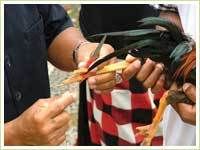 Tumpek Wariga and Tumpek Kandang
Tumpek Wariga and Tumpek Kandang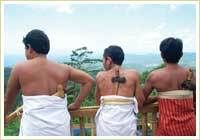 The inclusion to the Tumpek Landep ceremony of offerings to machinery and other steel, iron and metallic modern products suggests at least two interrelated points. Firstly, it reflects the flexibility of the Balinese's beliefs and traditions. The Balinese's beliefs and traditions have proven to be adaptable and relevant to modern life. Some may not feel safe in operating new engines or driving new cars without first given them a blessing ceremony. Others may believe that accidents in the operation of an engine or the driving of a car may be caused by carelessness during a ceremony on Tumpek Landep. This belief remains strong in modern day Bali. This is a noticeable point as ceremonies on Tumpek Landep have become more and more elaborate over time. This practice further suggests that the more modern the Balinese the more traditional they become.
The inclusion to the Tumpek Landep ceremony of offerings to machinery and other steel, iron and metallic modern products suggests at least two interrelated points. Firstly, it reflects the flexibility of the Balinese's beliefs and traditions. The Balinese's beliefs and traditions have proven to be adaptable and relevant to modern life. Some may not feel safe in operating new engines or driving new cars without first given them a blessing ceremony. Others may believe that accidents in the operation of an engine or the driving of a car may be caused by carelessness during a ceremony on Tumpek Landep. This belief remains strong in modern day Bali. This is a noticeable point as ceremonies on Tumpek Landep have become more and more elaborate over time. This practice further suggests that the more modern the Balinese the more traditional they become. Today, ceremonies on Tumpek Landep are extended to ritualize all objects made of metal, including cars, motorbikes, trucks, computers, televisions, digital cameras and machinery. Machinery, vehicles, and other goods are washed and cleaned prior to the ceremony. Transport companies who own several cars or buses, printing companies, rice-milling factories and all other factories normally close operations on Tumpek Landep day. Metallic objects are blessed through quite a large ceremony with elaborate offerings; perhaps completed with the sharing of a suckling pig, the ultimate show of a successful ceremony. The goals are the same; on one hand, Lord Pasupati is honoured and on the other hand, operational functions are maintained, thus helping day-to-day usage. People also believe that a lack of ceremonies could cause the metallic objects to malfunction. Therefore, the Balinese usually perform a 'melaspas' ceremony for every new metallic object before its use or operation. During the ceremony, it is hoped that the Gods will bless the objects as well as their users. In the recent past, a jumbo jet at Bali Ngurah Rai airport was even witnessed being ritualized before starting to serve a new international route! However, ceremonies of small metal goods or big machinery such as trucks continue to be held every Tumpek Landep and on holy days such as Kuningan.
Today, ceremonies on Tumpek Landep are extended to ritualize all objects made of metal, including cars, motorbikes, trucks, computers, televisions, digital cameras and machinery. Machinery, vehicles, and other goods are washed and cleaned prior to the ceremony. Transport companies who own several cars or buses, printing companies, rice-milling factories and all other factories normally close operations on Tumpek Landep day. Metallic objects are blessed through quite a large ceremony with elaborate offerings; perhaps completed with the sharing of a suckling pig, the ultimate show of a successful ceremony. The goals are the same; on one hand, Lord Pasupati is honoured and on the other hand, operational functions are maintained, thus helping day-to-day usage. People also believe that a lack of ceremonies could cause the metallic objects to malfunction. Therefore, the Balinese usually perform a 'melaspas' ceremony for every new metallic object before its use or operation. During the ceremony, it is hoped that the Gods will bless the objects as well as their users. In the recent past, a jumbo jet at Bali Ngurah Rai airport was even witnessed being ritualized before starting to serve a new international route! However, ceremonies of small metal goods or big machinery such as trucks continue to be held every Tumpek Landep and on holy days such as Kuningan.
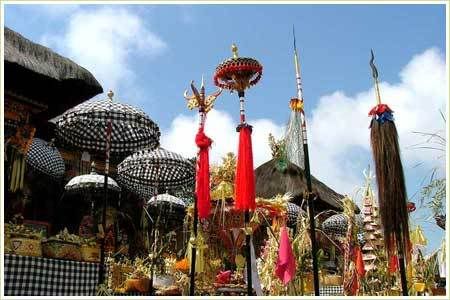 At least four times a year visitors to Bali
At least four times a year visitors to Bali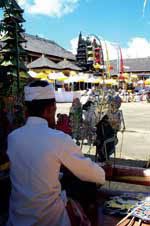 Another type of shadow puppet is based on pure entertainment. The story will be taken from either a part of the 'Mahabharata' or 'Ramayana' epics, although the aim of the performance is purely to entertain the public. In this case, the puppeteer will dominate the show with the jokes and funny movements of his puppets. Political satire, sexual innuendos, insults, and riddles usually dominate such a performance. Mixed language between Balinese, Indonesian, and a bit of English has also become a key ingredient in the performance. The following puppeteers have become popular for their amusing shadow puppets; the late Dalang Lukluk, Dalang Joblar, and Chenk Blonk. During his performance, Chenk Blonk does not use a 'blencong' but prefers electric lamps. This is very modern. When he is chosen to entertain, Chenk Blong rarely accepts to perform a 'sapuleger' show. He prefers his shows to be recorded and sold on compact disc and is proving to be quite popular.
Another type of shadow puppet is based on pure entertainment. The story will be taken from either a part of the 'Mahabharata' or 'Ramayana' epics, although the aim of the performance is purely to entertain the public. In this case, the puppeteer will dominate the show with the jokes and funny movements of his puppets. Political satire, sexual innuendos, insults, and riddles usually dominate such a performance. Mixed language between Balinese, Indonesian, and a bit of English has also become a key ingredient in the performance. The following puppeteers have become popular for their amusing shadow puppets; the late Dalang Lukluk, Dalang Joblar, and Chenk Blonk. During his performance, Chenk Blonk does not use a 'blencong' but prefers electric lamps. This is very modern. When he is chosen to entertain, Chenk Blong rarely accepts to perform a 'sapuleger' show. He prefers his shows to be recorded and sold on compact disc and is proving to be quite popular.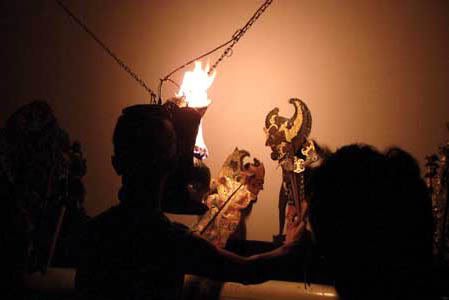 Most Balinese performing arts are considered sacred although there is a wonderful balance of entertainment involved. Shadow puppets are a good example. This is one of the most sacred of the performing arts as most shows are performed ritualistically, although their quality and popularity are not only dependent on how good the puppet master presents the story and moral values, but also as to how entertaining their presentation is.
Most Balinese performing arts are considered sacred although there is a wonderful balance of entertainment involved. Shadow puppets are a good example. This is one of the most sacred of the performing arts as most shows are performed ritualistically, although their quality and popularity are not only dependent on how good the puppet master presents the story and moral values, but also as to how entertaining their presentation is.
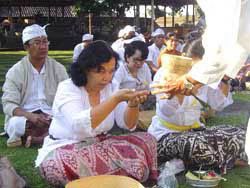 Nowadays, purnama in Sanur is still beautiful, but people do not need to wait to come to the beach on that day. People can come to Sanur every day if they like. Purnama and Sanur no longer have a strong connection. The tall building on Sanur beach, which used to be considered so splendid, has now lost its attractiveness. Also, the number of places for recreation has increased; now it is mainly malls and cafes where teenagers like to hang around at the week end.
Nowadays, purnama in Sanur is still beautiful, but people do not need to wait to come to the beach on that day. People can come to Sanur every day if they like. Purnama and Sanur no longer have a strong connection. The tall building on Sanur beach, which used to be considered so splendid, has now lost its attractiveness. Also, the number of places for recreation has increased; now it is mainly malls and cafes where teenagers like to hang around at the week end.The romantic dimension of the full moon has become less celebrated by teenagers nowadays. Changes have taken place, marked by more spiritual activities, held on purnama day. On the night of purnama, young people around the town of
The spiritual dimension of purnama has been very strong recently. Every purnama, many primary and secondary school students in Denpasar, and in other regions throughout
Using Balinese traditional costume (pakaian adat) is an important development in Balinese society; especially among the young generation. They are proud of their traditions and this is in contrast to what happened in the 1950s and 1960s. Young people were then ashamed to wear Balinese attire. If they went to temple some distance away by bicycle, they tended to wear trousers on the way and kept their Balinese clothes in a bag. They only put them on when they arrived in the temple. After praying, they wrapped up the pakaian adat again and put them back in the bag. However, nowadays, things have changed dramatically and the changes are supported by the promotion of purnama as the day for Hindu students to wear Balinese costume.
Schools have started to use the so-called
Visitors who happen to have purnama during their holiday in
On the day of the full moon, Balinese people usually do tirta yatra or pilgrimage to their family or main Hindu temples such as Besakih, Tanah Lot, and Uluwatu. Some often go to pray to
Although we are focusing upon the full moon in this article, it should be mentioned that 'Tilem', the dark moon, is also an auspicious day in the Balinese calendar.
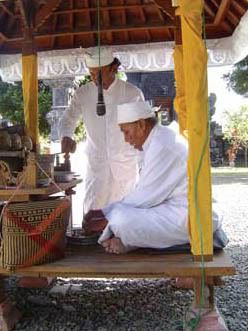 Purnama or full moon is an auspicious day to Balinese people. Many important Hindu rituals fall upon or are held at this time. The day is believed to bring happiness both socially and spiritually. The significance of purnama, however has changed over recent times.
Purnama or full moon is an auspicious day to Balinese people. Many important Hindu rituals fall upon or are held at this time. The day is believed to bring happiness both socially and spiritually. The significance of purnama, however has changed over recent times.In the past, say four or five decades ago, purnama had more meaning for romantic things, while its ritual dimension was rather insignificant. Between the1950s and 1970s, purnama was the day that teenagers were always very much looking forward to. On the purnama day, they enjoyed the brightness of the night by going to the beach. Teenagers in Denpasar, for example, went to Sanur beach to enjoy the beauty of the full moon. Many people also swam at the beach that night. They believed that by swimming at the beach on purnama day, they were not just cleaning their bodies but also their minds.
Because the transport facilities before the 1970s was not as modern as nowadays, Denpasar inhabitants went to Sanur by bicycle. Limited street lighting on the road was not an obstacle to their travelling by bicycle because the moon poured its shining light on the road. One after another bicycle usually went to Sanur on the night of purnama. The light of the moon not only eased the ride but also accentuated the romance of their journey.
On the purnama night, Sanur beach was packed with people, usually until midnight, when most of the visitors went home. People avoided hanging around at the beach until late at night because of the magical images of the area. Besides going to Sanur at purnama, teenagers also liked to go to the cinema. New releases of films were often shown for the first time at purnama so as to be able to attract a bigger audience. Sanur beach and the cinema were among the few places available for recreation at that time.
Going to Sanur for teenagers also let them see the 'splendour' of the first and only ten storeyed building in
Nowadays, purnama in Sanur is still beautiful, but people do not need to wait to come to the beach on that day. People can come to Sanur every day if they like. Purnama and Sanur no longer have a strong connection. The tall building on Sanur beach, which used to be considered so splendid, has now lost its attractiveness. Also, the number of places for recreation has increased; now it is mainly malls and cafes where teenagers like to hang around at the week end.
The romantic dimension of the full moon has become less celebrated by teenagers nowadays. Changes have taken place, marked by more spiritual activities, held on purnama day. On the night of purnama, young people around the town of
The spiritual dimension of purnama has been very strong recently. Every purnama, many primary and secondary school students in Denpasar, and in other regions throughout
The prelude scene, marked by a couple of mask dances, was followed by several scenes that led into a plan for a big ritual in the palace such as a wedding. Since the king was respected by his people, he then received a lot of support to make the party run smoothly. The three funny characters enthusiastically come to the palace as representatives of the people.
Using a mixture of languages - Balinese, Indonesian, and a bit of English, the arrogant man comes first, and says how he will dedicate his skill to the wedding ritual. Identifying himself as a civil servant who works at an upper level he appears so confident yet hilarious. He uses a lot of word games, mixing language, and mocking references to modernity and current issues in tourism, thereby giving fresh and authentic jokes for the audience.
As for the other two characters, the chubby-cheeked lady and the deaf old man, although looking very old, the woman introduces herself as a virgin and still a university student. When the king's adjutant welcomes and mocks her as an old and unattractive woman, she then gives the man a lesson by showing her high knowledge of moral and religious values. The funny elements from the character of the deaf old man come from the dialogue between the two, which is full of misunderstandings. Although almost all bondres characters are depicted as stupid, they also sometimes appear as smart and literate people who know a lot about history, tradition, and religious values; reflecting the high literacy level of the dancer, Ngurah Windia.
The Topeng Tugèk Carangsari was very popular throughout the 1980s and 1990s. They were invited not only for ritual or ordinary performances but also used by government institutions and NGOs to promote ideas including 'awareness of tourism', 'awareness of law', on family planning, and on road traffic. Now their dancers are getting old and are unable to perform with the original team. Moreover, their jokes are losing some of their humour since they have been continually recycled by other bondres groups.
The Topeng Tugèk Carangsari group has been very influential. Almost all bondres groups have copied its format with very little adjustment. Mask-dance groups from Denpasar, Badung, and even from
Recently, many bondres have left out the stories from their performances and transformed it into pure comedy. After the
Balinese people have a great sense of humour. This can be seen through their visual arts such as painting, sculpture and the performing arts; including the sacred puppet-shadow and mask dance. Clown characters that make jokes and help audiences understand stories are pre-eminent in all of the Balinese performing arts.
One of the most popular forms of performing arts that is dominated by or often focuses upon only humorous elements, is bondres, also known as topeng bondres. Topeng in Balinese means mask, while bondres refers to comic characters. Topeng bondres means an amusing form of mask used by dancers to make a comical appearance.
Bondres became known in the mid 1970s through the birth of a mask dance group called Topeng Carangsari, named after the
The Topeng Carangsari was the first group of mask-dancers to create the typical clown and they made the whole performance entertaining through their fresh, original, and smart jokes. Mask-dance used to be a sacred or serious dance, usually performed to accompany a ritual such as a temple festival or a particular stage in a cremation ritual. When the mask-dance transformed into a performing genre, like prembon, by performing particular stories such as the genealogy of a king or clan, they were hardly entertaining and quite boring. Suddenly, Topeng Carangsari lead by a talented dancer, I Gusti Ngurah Windia, came up with great format of mask-dance which is called topeng tugèk Carangsari. Tugèk means 'chubby beautiful lady'.
Topeng Tugèk Carangsari created three distinctive characters who are a chubby-cheeked lady, the hare lipped arrogant man, and a deaf old man. These three characters have similar important roles, which are to articulate the story and to make audiences laugh. Interestingly, these characters were all played by one dancer, Ngurah Windia, who also played other characters such as a priest and king's adviser or enemy. He played each role just by changing masks and voices accordingly. The total number of topeng dancers is six. Other characters are the princess and her follower, the king (played by a female dancer) and two of his male adjutants. They were quite a solid group.
 Pengibing are attracted to dance, not just because they like it, but also because they are attracted by the charms of the joged. It is not unusual for one or two of the more adventurous young men to try to move his hips so he can touch the joged's hips, or even to steal a quick kiss. The more beautiful a joged dancer is, the greater the number of men volunteering!
Pengibing are attracted to dance, not just because they like it, but also because they are attracted by the charms of the joged. It is not unusual for one or two of the more adventurous young men to try to move his hips so he can touch the joged's hips, or even to steal a quick kiss. The more beautiful a joged dancer is, the greater the number of men volunteering!Joged has a long history. In the kingdom era, early 19th century in
Unfortunately, the negative image of joged dancers continues until the present time. After the reformation era, joged became a wild performance in terms of its hip shaking and erotic movements.
The distribution of a VCD of pornographic jogged, filmed using an amateur video in 2002, made the negative images of joged even worse. In this and in following years, images of joged caused public controversy; many people liked to watch a 'wild joged', while others accused it of not being in accordance with moral values.
Joged had usually been performed in the annual Bali Arts Festival but, as a consequence of the joged porn VCD, the performance disappeared from the 2004 Bali Arts Festival. Interestingly, at the national level, issues of erotic gyrations of the young dangdut singer Inul Daratista also sparked controversy, but it has been allowed and accepted by the dominant view as a type of performing art.
Ideas to promote joged came up and were welcomed as long as the dance developed without any tendency to sensual or sexual movement. A 'Festival ngibing' was held to improve the politeness and dancing ability of spectators when invited to dance. Additionally, the aesthetic aspect of the dance was emphasised.
After some efforts to minimise wild aspects of joged, it reappeared in the Bali Arts Festival 2005. As expected, it was in a more polite form though the tendency to the hot shaking hips and kiss-stealing has not disappeared at all.
Joged has often been performed to entertain a group of tourists with the main aim of creating a cheerful and fun occasion where tourists, male and female, can experience stretching their hands for a Balinese dance! The happy and entertaining quality of joged much depends upon where it is performed and who are the audience.
 also known as joged bumbung; referring to the instruments made of bamboo used to accompany it. In the Indonesian and Balinese languages, joged means to shake the hips. A joged dancer wears relatively unelaborate attire, comprising a kebaya and sarung. Her head, either with or without gelungan, is decorated with fresh and gold-plated flowers and she will be holding one or more fans while dancing. The fans are used to touch spectators in order to invite them to join the dance.
also known as joged bumbung; referring to the instruments made of bamboo used to accompany it. In the Indonesian and Balinese languages, joged means to shake the hips. A joged dancer wears relatively unelaborate attire, comprising a kebaya and sarung. Her head, either with or without gelungan, is decorated with fresh and gold-plated flowers and she will be holding one or more fans while dancing. The fans are used to touch spectators in order to invite them to join the dance.The renewal of the arts during the 30’s saw a surge in dance creativity, producing dances that are still the most popular in Bali : short but spectacular non-narrative dances inspired by the dynamism of the Gong Kebyar, a Gamelan orchestra originating from
These dances are performed to welcome visiting Gods, who are presented with offerings of flowers. Nowadays tourists are also showered with flowers.
“Topeng” means mask and the mask dance related the tales of Balinese and Javanese ancestors returning temporarily to inhabit the mask. Nowadays, the main stories, with their princes and clowns, are preceded by a set of solo mask dances for men – the “Topeng Keras”, or dance of the “Strong Warrior”, the “Topeng Tua” – a fantastic dance showing the advance of old age in the king’s old counselor, and the “Topeng Dalem” – showing the king in all his glory with enough clowns to fill a circus.
The Gambuh is the oldest classical dance in
The famous Legong Dance is the epitome of classical female Balinese dancing. A court dance, it was created in the 18th century in the circles of the principality of Sukawati. According the legend, in the mid-18th century, I Dewa Agung Made Karna who was meditating for 40 days and nights saw two dancing celestial angles. After his meditations, he passed on what he had seen and heard to his court dancers and musicians. The Sanghyang Legong was born.
Now including a variety of modern “free creation” (tari lepas), the legong is usually the first dance taught to beginners. Months of training are needed to master the perfect mix of posture (tangkep), movements and mimicry. Three dancers in glittering costumes – one condong lady – In – waiting and two princesses whose roles change according to the narrative – usually perform it. The ancient Legong used to have a storyteller’s accompaniment, but these days they are only dance performances.
The fight between Barong and Rangda is also the topic of traditional narratives, usually performed in the temple of the dead. The most famous is the story of Calonarang, a widow from Jirah who furious because she cannot find a suitable husband for her daughter Ratna Manggali. All the eligible young men are scared of her black magic, so she gets revenge by wreaking havoc over the
narratives, usually performed in the temple of the dead. The most famous is the story of Calonarang, a widow from Jirah who furious because she cannot find a suitable husband for her daughter Ratna Manggali. All the eligible young men are scared of her black magic, so she gets revenge by wreaking havoc over the
But the witch does not heed Durga’s advice and the kingdom is soon hit by grubug (a plague) and the villages quickly become cemeteries, people dying even before they can bury their dead. Corpses are scattered everywhere and the stench is unbearable.
The only person who can defeat the witch is Mpu Baradah. At the king’s request, Baradah sends his disciple Bahula to steal Calonarang’s magic weapon. Bahula pretends to ask for Ratna Manggali’s hand in marriage, and while the witch away, Bahula steals the magic weapon with the help of Ratna Manggali. Then he gives the stolen weapon to his teacher Baradah. The weapon turns out to be a manuscript containing the key to ultimate release (moksa) which has been used upside-down by Calonarang.
Baradah goes to Daha to challenge the witch. With the help of the Barong, she is defeated. Before being killed, she asks to be release from her curse and purified.
